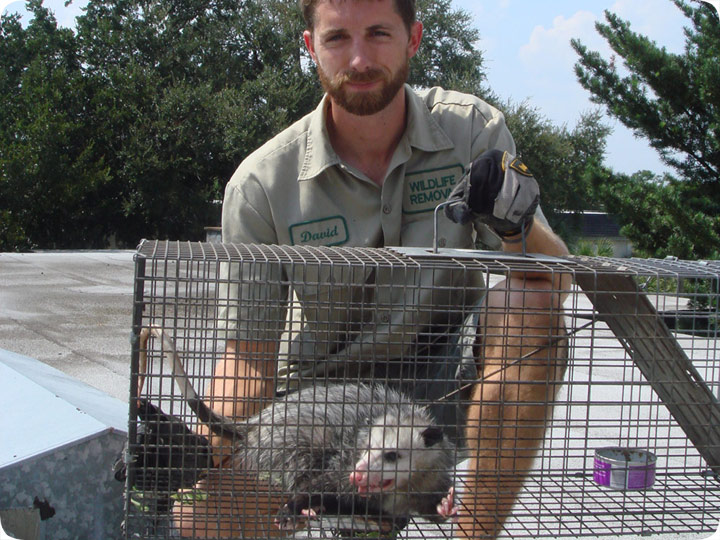-
info@aaanimalcontrol.com
Call us for help in your town
Humane Wildlife Education
Animal on the Roof - Opossum

08.01.2005 - Most of my customers call me to complain about the noises that they hear an animal making. Most of the time, these noises are from animals living inside the attic or walls of a house. However, from time to time people hear animals scratching and clawing on the
roof. I do many jobs in which I simply trap and remove animals that have a habit of spending time on the roof and making noise night after night. Some of the time these are animals that have incorporate a roof into their normal nighttime routine rout, but most of the time, the
critter is on the roof because it is in fact nesting there or going into the attic
Animals nest on roofs if there's good habitat and shelter. If, for example, there's
eaves or other architectural features to hide under, that'll attract animals. If there's a collection of debris, such as tree limbs and leaves, that will attract critters
as well. If there's easy access to the roof, such as from an adjacent tree, that will also encourage animals to use the roof.
I deal with all sorts of animals
on roofs. In this case, it was an opossum that I caught on a roof. This was actually at an apartment building, and not a private residence. You can see trees
near the roof, and cats and possums were climbing up the trees and actually going in the attic of this building. They spent a lot of time on the roof as well, as
evidenced by the tracks and droppings that I saw up there.
I set multiple traps on the roof. When roof trapping, it's very important to check the traps early each
day. You can't leave a trapped animal on a roof with no shade from the hot sun, or it might overheat and die. I got this opossum this morning, and relocated it far
away from any roofs.
Do it yourself: Visit my How To Get Rid of Opossums page for tips and advice.
Get professional help: Visit my Nationwide Pro Directory of wildlife removal experts.
For more wildlife stories, click my Wildlife Blog
or click my below banner to hire a local trapper.
Hearing an opossum rustle around in your attic is one of the most frustrating sounds you can endure. Endless scuffle noises above your ceiling can drive you crazy and make you believe the creature is taunting you. Thankfully with the right tools and information, you can keep your roof opossum-free in a few simple steps.
Before you begin the process of keeping your roof and attic clear of opossums, you must first ensure there are no holes that can lead them into your house. If there are any, they need to be blocked off with a sturdy material like metal that the animal cannot chew or claw through. Opossums are expert climbers, if there are any trees or fences within close proximity to your roof, they can use them as access points to your roof. Trees with long branches should be trimmed off and fences should be designed to prevent climbing in order to limit the access of pests onto your property. It is also important to get rid of all attractants that might lure opossums to your home. Attractants can include any garbage or trash left unclosed or unattended at night, open food, potent smells, and easy access to shelters such as open holes in warm dark places. You can use repellants to keep opossums away although some of these have been proven to be ineffective. You are probably better off using disinfectants to sanitize your surrounding areas and practicing good hygiene to prevent potent smells and clutter attracting opossums. After you have cleared off all attractants to prevent other pests from coming around, you can proceed to trap the opossum. Beware that opossum trapping is subject to clearly defined laws that may vary from state to state.
In some cases, when you have possums in your home, the only fix is to physically trap and remove them from your vicinity. Trapping opossums is more of an art form than it is a science. It's a trial and error process for many beginners. Most amateurs can go weeks before actually catching the nuisance animal. A deep understanding of how opossums behave can help speed up this process before and after trapping. Learning to trap opossums and other wildlife animals for that matter is important in order to avoid any accidents during the process. Transporting these animals can be dangerous if proper care is not taken. Here are some important steps to consider when trapping an opossum:
1. Determine if trapping is necessary, or if there is a preventative alternative.
2. Research and select the appropriate trap for your situation. There are about a dozen types of opossum traps on the market.
3. Set the traps in the best-suited areas. This would include shaded areas, camouflaged surroundings, and on flat surfaces that are clear of any obstructions
4. Choose the correct bait. Avoid meat-based products because they can attract other unwanted animals
5. Constantly monitor the trap and immediately remove and transport the trapped opossum to an appropriate space away from your area.




















